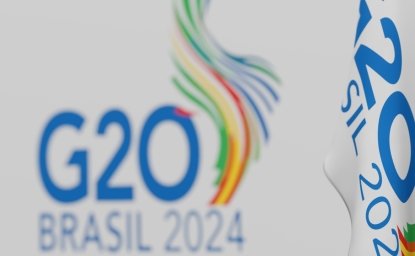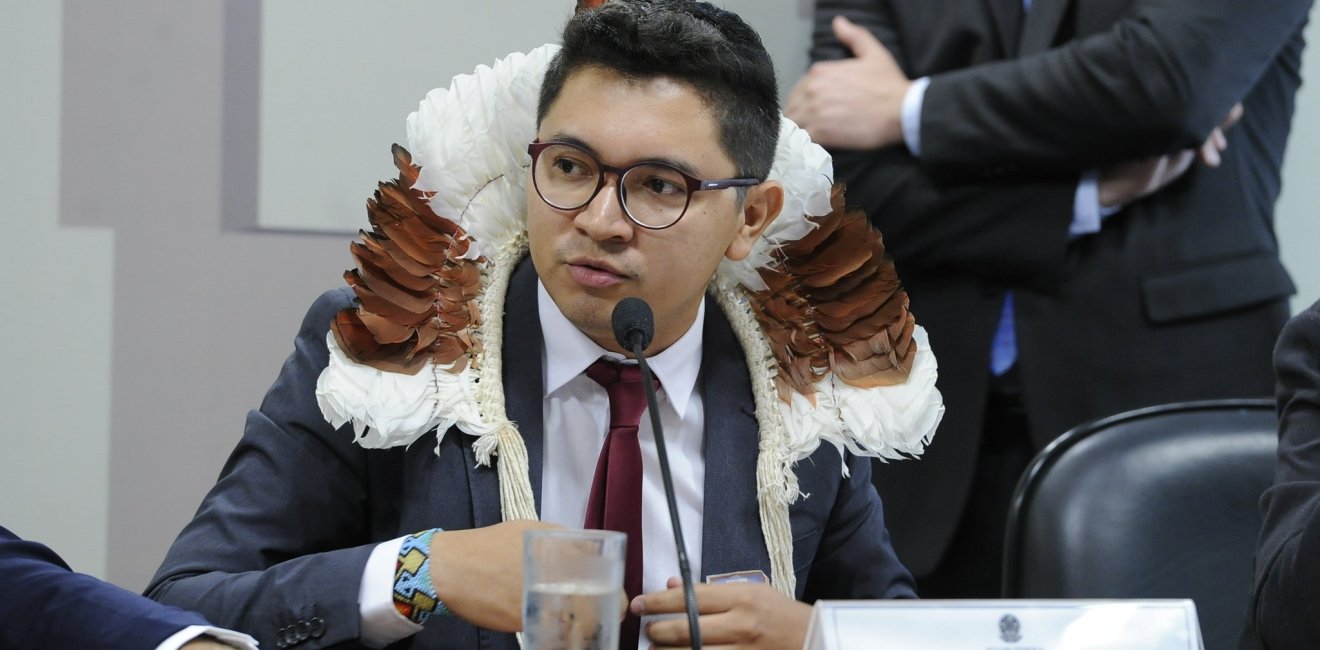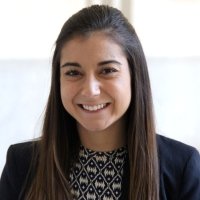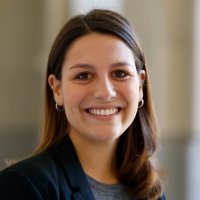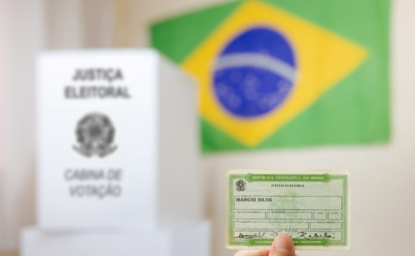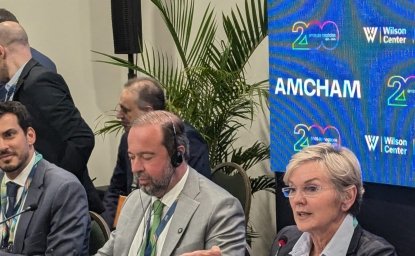
A blog of the Brazil Institute
This interview is also available in Portuguese, following the English version below / A entrevista está disponível em português, sob a versão em inglês. (Click here/Clique aqui.)
Luiz Henrique Eloy Amado, or Eloy Terena, as he is known, is a lawyer, researcher, and Indigenous land rights activist. From the Terena People, Eloy is a native of Ipegue village in Mato Grosso do Sul. He holds a doctorate in Social Anthropology from the National Museum (UFRJ), and a doctorate in Sociology and Law from the Fluminense Federal University (UFF). He conducted a postdoctoral research internship at Brandon University in Canada, focusing on territorial conflicts. Currently, Eloy is conducting a postdoctoral fellowship at the Interdisciplinary Institute of Social Issues (IRIS) at the School of Advanced Studies in the Social Sciences (EHESS) in Paris, France. He also serves as a legal advisor to the Brazilian Indigenous peoples Association (APIB).
The following conversation has been condensed and edited for clarity. The views and opinions expressed below are the interviewee's own, and do not necessarily reflect the views of the Brazil Institute or the Wilson Center.
You are part of a generation of Indigenous youth that had access to higher education. How does your background in law support your mission in defending the interests of Brazil’s Indigenous peoples? What is your message to other Indigenous teenagers that want to leave their communities to pursue higher education?
To be honest, I sometimes find myself reflecting on how everything happened in my life. I was born and raised in Ipegue village; I never dreamt that I would one day leave my village, much less become a lawyer. Since I was very young, my grandmother Julieta Antonio Pio would say that education is everything, though even she could not have imagined where it would take me. The general perception within the village was to study until eighth grade, so you could get a job that didn’t involve harvesting sugarcane in Mato Grosso do Sul or submitting to hard labor on the region’s farms.
At the time, the village only offered up to fourth grade. Anyone who wanted to continue their education had to leave the village. When I finished fourth grade, I had three options: go work on the farms in the region, cut sugarcane at the mills, or continue to study. It was very tough because my family did not have much financial means. It was only the sons of the caciques (chiefs) or those with relatives and friends in the city that had a chance to go to the city, and that was not my case. It was at that moment that I relied on the decisiveness of my mother Zenir Eloy, who was already a single mother raising myself and my three sisters (Val Eloy, Simone Eloy, and Claucinéia Eloy).
My mom decided to go work as a maid in the city of Campo Grande, living in her employer’s house. After a year, she returned to the village to take us to study in the city. In Campo Grande, my mom always insisted that I dedicate myself to my studies. At one point, she even worked three different jobs at the same time. I successfully completed middle school through the public school system, and in 2004, I took an entrance exam for law school at the State University of Mato Grosso do Sul (UEMS), competing for an Indigenous quota spot [1].
While studying in university, I never forgot my roots. I found myself looking to get more involved with the problems confronted by the communities in Mato Grosso do Sul, and it was then that I realized just how much Indigenous peoples needed legal advice regarding land claims. Starting then, even while a student, I began [organizing] legal training workshops for Indigenous leaders; and after graduating, I started practicing as a lawyer working on demarcation proceedings for Indigenous lands. First, in Mato Grosso do Sul and later before the Brazilian Supreme Court and internationally.
My message to Indigenous youth is that Western education is an instrument that we can use to make our demands possible. It allows for our voice to be heard by other people. It also provides an opportunity to critically reflect on the challenges faced by Indigenous peoples in order to overcome internal colonialism, break barriers, and empower ourselves to determine our own story.
In the legal area, you work heavily with Indigenous land demarcation. Why is the topic of demarcation so important to the Indigenous population? Can you talk a little bit about your work in 2017 and the marco temporal legal concept [2]?
Indigenous peoples are affected by various social problems, racism, lack of health and education assistance, high rates of suicide, and child malnutrition in some regions. In our perspective, all of those problems are related to lack of territory, since the dignity of the Indigenous person stems mostly from their territories—their existential foundation.
In 2017, as a legal advisor to the Articulação dos Povos Indígenas do Brasil (Brazilian Indigenous peoples Association, or APIB), we started a campaign called “Nossa História Não Começa em 88” (Our History Didn’t Begin in ’88). This campaign is a counterpoint to the legal thesis known as the marco temporal, which is under discussion in the Supreme Court. For those who are adherents of this legal orientation, the Brazilian Constitution would only recognize Indigenous lands that were occupied as of October 5, 1988, the date of the promulgation of the Constitution.
In August of 2017, the Supreme Court added three cases to the trial agenda that would address the rights of Indigenous peoples: two referencing lands in Mato Grosso and another referencing the land of the Kaigang people. In response, we launched the campaign to raise awareness among the Justices of the precepts of the Constitutional Charter, which recognized the original right of Indigenous peoples and did not impose any sort of precondition or temporal mark. The campaign involved a series of activities including seminars at law schools such as the University of Brasilia (UnB), the University of São Paulo (USP), the Pontifical Catholic University of Rio de Janeiro (PUC-Rio), and the Fluminense Federal University (UFF) among others; trips by Indigenous leaders to Brasilia, and a visit to the offices of the Supreme Court justices.
On the day of the trial, the lawsuit of the Kaigang people, which would have challenged the marco temporal thesis, was removed from the agenda and only the two cases regarding the lands located in Mato Grosso were heard. While neither case dealt directly with the marco temporal thesis, the Supreme Court reaffirmed the adoption of the ‘theory of indigenato’ by way of the Constitution, that is, that the rights of Indigenous peoples are original and that the 1988 Constitution was not the first to recognize that guarantee. On the contrary, since the Royal Letters of the Brazilian Colony, the Brazilian State has been legislating to guarantee Indigenous peoples the possession and the enjoyment of Indigenous peoples their territories. This was an important ruling in which the Supreme Court signaled that the marco temporal thesis was not going to be upheld, although a final statement on the judgment is still missing.
Since 2009, you have been conducting community workshops focused on legal education, which address topics related to the Indigenous movement at the national level. What have been the results of these workshops? Do you intend to continue them?
The rights of Indigenous peoples are not addressed in the law school curriculum, therefore, it requires an individual effort to obtain that information. In my case, during graduate school, I had the opportunity to participate in an extension course on Indigenous rights, held under the program “Knowledge Network Program: the permanency of Indigenous peoples in higher education,” created for Indigenous law students. Upon completion of this course, our mission was to return to our communities and to offer workshops for our caciques, as well as women and youth leaders. It is astounding how much these communities are in need of information about their rights. The workshops--which were first carried out in the villages of Mato Grosso do Sul with the Terena and Guarani Kaiowá peoples; then in other regions of Brazil, with the Cinta Larga people and the Arara in Mato Grosso; and then the Tiriyó, Apalai, Kaxuiyana and Wayana in Pará--are spaces for critically reframing Rights from the Indigenous standpoint, prioritizing dialectical argumentation from the Indigenous worldview.
The workshops are legitimate instruments for the Indigenous struggle, since the moment that Indigenous leadership obtains knowledge of their rights, they immediately rearticulate those legal arguments in their political practices. I believe that these workshops constitute real instruments capable of awakening Indigenous peoples to their rights and qualifying the Indigenous fight within the legal and political field.
Can you speak about your involvement with the Articulação dos Povos Indígenas do Brasil (Articulation of the Indigenous peoples of Brazil, or APIB) and the Coordenação das Organizações Indígenas da Amazônia Brasileira (Coordination of Indigenous Organization from the Brazilian Amazon, or C.O.I.A.B.)? How do these organizations work to change politics and public opinion, in support of their missions?
The Articulation of the Indigenous peoples of Brazil (APIB) is formed up of Indigenous regional organizations which are: the Coordination for Indigenous Organizations in the Brazilian Amazon, (COIAB), the Articulation of the Indigenous peoples in the Northeast, Minas Gerais, and Espírito Santo (APOINME), the Articulation of Indigenous peoples of the Southeast (ARPINSUDESTE), the Articulation of the Indigenous peoples of the South (ARPINSUL), the Guarani Yvyrupá Commission, and the Council of the Terena and Aty Guasu Kaiowá Guarani peoples.
In 2012, I started advocating for the Terena and Aty Guasu Council, focusing on cases in Mato Grosso do Sul, given the intense territorial conflicts in the region and the growing judicialization of the Indigenous land demarcation process, a phenomenon that is continuously growing. In 2016 I was invited to work in Brasilia as a legal advisor for APIB, now working on the Indigenous national agenda, notably in the Supreme Court hearings and the legislative proposals in process at the National Congress. It was within this context that I grew close to COIAB’s Indigenous leadership because I was involved in several of the legal demands regarding the interests of Indigenous peoples in the Amazon, such as the right to prior, free, and informed consent, restated in Convention 169 of the International Labor Organization (ILO), and [I was] following issues related to mining in Indigenous lands and the constant threats perpetrated against Indigenous peoples in voluntary isolation.
Both APIB and COIAB are Indigenous organizations that have a common mission to defend the rights and interests of Indigenous peoples. And, [in order] to talk about Indigenous peoples rights, [you] have to talk about their territory and their due protection. There is no doubt that land is essential for Indigenous peoples; actually, it isn’t possible to think of Indigenous peoples without land. However, over these last couple of years, we have been promoting a very clear message to everyone: “demarcating Indigenous lands does not only benefit the Indigenous! Demarcating Indigenous land is good for all of humanity!” It is proven that Indigenous territories are more preserved since Indigenous peoples protect with their own life the richness and diversity of life, contributing even to environmental equilibrium and for that reason, contributing to the well-being of all of humanity.
In Brazil, this perspective is clear when you look at the constitutional treatment given to Indigenous lands. These spaces have at least triple constitutional ruling because it is a good of the union, and so it is a public good. They [these spaces] serve as protection for the traditional way of life of these peoples and in turn protect the environment. For that reason, we have been working so hard to bring this message into the consciousness of society.
Part of your work now deals with defending the rights of Indigenous peoples in Brazil through meetings and lectures (now virtual) with international actors. What are the advantages of engaging with international companies and organizations, and not only Brazilian?
Since 2015 we have been doing what we like to call “international influence,” occupying international spaces to talk about what is happening with Indigenous peoples in Brazil. In May of 2019, for example, I participated in a BlackRock shareholders meeting and our objective was to alert them of the risks of their investments in our communities. BlackRock is one of the main funds investing in Brazilian agribusiness. During the meeting, a report was presented to the shareholders, highlighting very high profits and I went there to talk about other numbers, such as the increase in deforestation caused by growing agribusiness, the number of Indigenous leaders killed as a result of land conflict; in the end, they are also responsible for all of these things that are happening in Brazil. Our message was clear: “we are not against development, but it is necessary to respect the rights of Indigenous peoples and the environment, or else not even your grandchildren will have a guaranteed future.” One of our demands called for the implementation of internal control instruments to determine where these funds are being invested since we cannot have them continue to fund Brazilian companies that do not respect the environment and/or operate in areas recognized as Indigenous territory. That is a form of advocacy that we are doing internationally.
There are several challenges facing Brazil’s Indigenous populations: the proposal of the Marco Temporal, the budget cuts to FUNAI, the fires in the Amazon, and the current government’s intention to open Indigenous lands for economic activity, such as mining. What are some projects or public policies that you are working on to address these challenges?
We have been carefully following the scenario in Brazil since we have for the first time a president that is openly anti-Indigenous, and a conservative Congress allied with the congressional farm lobby (Frente Parlamentar da Agropecuária) which represents 44 percent of the representatives in the Chamber and the Senate. The Indigenous movement’s stance continues to be one of resistance towards proposals that are being made without consultation or consent of Indigenous peoples. Our main issue is without a doubt that of demarcation and protection of Indigenous territories, but in this government, we do not have the best prospects. The current Brazilian government understands demarcating Indigenous land as part of an ideological attitude aligned with a particular political ideology other than its own, when in fact it is a constitutional determination, liable even to those who deliberately delay this constitutional command. It is necessary to look at Indigenous peoples and respect their ways of life, their self-determination, and the priorities that each peoples have chosen for themselves.
Within the judicial realm, we are struggling to overcome the legal thesis of the marco temporal, which is an interpretation made by some jurists that restricts the rights of Indigenous peoples. For those who defend this thesis, the Constitution would have applied within a fixed date, that is, it would recognize Indigenous rights to lands that were occupied only as of October 5th, 1988, the date of the Constitution’s promulgation. When in fact, at no moment does the Constitution state this. There is no place where the Constitution deals with temporal elements, instead [it deals] with requirements regarding tradition, such as how the Indigenous peoples relate to their territory. When Article 231 states that the Indigenous peoples are recognized as having the “original right over the lands that they traditionally occupy,” it is reaffirming the theory of indigenato, rooted in colonial legislation that recognized the Indigenous as the “natural masters of their lands.” The truth is that many people know about the rights of the Indigenous peoples but they use this argument [of the marco temporal] to legitimize the seizure of Indigenous territories with a clear racist attitude (and in this case, one of socio-environmental racism) that finds fertile ground within the field of law to give rise to interpretations that benefit economic interests to the detriment of the country’s ethnic minorities.
Looking forward, what is the best way to protect and preserve Indigenous rights in Brazil?
Throughout history, Indigenous peoples have demonstrated a profound capacity for qualified resistance. I call it qualified resistance to underscore the contrast with a passive situation where your rights are continuously violated and no action is taken. On the contrary, Indigenous peoples, through their leadership and their own organizations, have created instruments during various historical situations to confront these attacks that in large part come from the State, which should be defending the interests of these original peoples. In each context, leaders have appropriated symbols, languages, and instruments that at many times are considered strange to the Indigenous culture to implement their institutional projects. That is right, the Indigenous peoples have their own projects, their own ways of seeing and understanding the world around them, and depending on the relationship that is established, they can or cannot use certain strategies.
For that reason, we have to pay a lot of attention to the qualified resistance of the Brazilian Indigenous movement. I have noticed a lot of commentary on social media stating that “Indigenous [rights] are a political maneuver used by the left-wing,” or that “Indigenous peoples were corrupted by Marxist ideology,” and some people even question “where were these Indigenous groups during the Lula and Dilma governments?” These comments reveal that people know little to nothing about Indigenous peoples, for Indigenous leaders have always been there in the political sphere defending their rights. And as dark as the moment is, it is not yet the “end of the Indigenous peoples,” as some seem to believe.
Indigenous issues have been at the center of Brazilian political discussion and in the international sphere, not by chance: Indigenous peoples and territories are living barriers to the development model adopted in Brazil, where profit is prioritized above everything. I remember the Guarani Kaiowá leader, Anastacio Perlata, who during the Dilma government had already denounced that an ox was worth more than an Indigenous child in Mato Grosso do Sul. The clashes over Indigenous rights have gained ground because, for the first time in the post re-democratization period, we have a president who is openly anti-Indigenous, who during his electoral campaign committed to not demarcating a centimeter of Indigenous or quilombola land. As if the demarcation of Indigenous land was a political benevolence and not a constitutional right. Many people do not understand the importance that these territories have, not only for Indigenous peoples but also for humanity. Indigenous territories are the most protected areas and are responsible for environmental balance, for the protection of biodiversity, for the protection of rivers and lakes, and for that reason, these vital spaces are not only for the people who inhabit them, but also, above all, for those who live in large urban centers.
I have said in many instances that Indigenous peoples have a lot to teach “white people.” The quality of resistance that developed over centuries of genocide is an important observation for any society that seeks to consolidate itself as an enduring organism within the moment in which we live. Thus, reconciling the political, social, and economic factors--when the guiding light of these principles are beyond our physical orbit and follow hierarchic commands that often only the Indigenous are capable of understanding and transiting between these two worlds--can be translated into the path of learning that Indigenous peoples have to offer to us all.
[1] In 2012, Law 12.711, also known as the “Quota Law,” passed, obliging federal higher education institutions to reserve spots for Indigenous peoples who have studied in public schools. According to the law, the number of places reserved for Indigenous peoples must be proportional to the number of people of a certain ethnicity residing in the state where the university campus is located.
[2] The concept of the marco temporal creates an arbitrary cut-off date for land claims, stating that Indigenous peoples only have the legal right to claim traditionally-held territory that they were physically occupying as of October 5, 1988: the date that the most recent federal Constitution was approved. The marco temporal was first adopted by the Supreme Federal Court (STF) in 2009 over boundaries for the Raposa/Serra do Sol Indigenous reserve in Roraima. Most recently, in 2017, former Brazilian president Michel Temer approved an Attorney General’s office recommendation with this legal thesis.
Entrevista com Dr. Eloy Terena, advogado e ativista pelos direitos indígenas
Luiz Henrique Eloy Amado, também conhecido como Eloy Terena, é advogado, pesquisador e ativista pelos direitos indígenas. Membro da tribo Terena, Eloy é originário da Aldeia Ipegue, Mato Grosso do Sul e possui um doutorado em Antropologia Social pelo Museu Nacional (UFRJ) e outro em Sociologia e Direito pela Universidade Federal Fluminense (UFF). Conduziu sua pesquisa pós-doutoral na Brandon University, no Canadá, com foco em conflitos territoriais. Atualmente faz pós-doutorado no Instituto de Pesquisa Interdisciplinar em Questões Sociais (IRIS), da Escola de Estudos Avançados em Ciências Sociais, em Paris, França.
A conversa a seguir foi condensada e editada para maior clareza. Os pontos de vista e opiniões expressos a seguir são do próprio entrevistado e não refletem necessariamente os pontos de vista do Brazil Institute ou do Wilson Center.
Você faz parte de uma geração de jovens indígenas que teve acesso ao ensino superior. Como sua formação em Direito ajuda sua missão de defender os interesses dos povos indígenas no Brasil? E qual sua mensagem para outros jovens indígenas que querem sair de suas comunidades para estudar na universidade?
Para ser sincero, às vezes fico refletindo comigo mesmo como tudo isso foi acontecendo em minha vida. Nasci e cresci na aldeia Ipegue, nunca imaginei que um dia sairia da aldeia. Sequer passou pela minha cabeça virar advogado. Mas desde muito cedo, minha avó Julieta Antonio Pio dizia que educação era tudo, embora, nem ela mesmo poderia imaginar onde isso chegaria. A percepção dentro da aldeia era estudar até a oitava série para buscar um emprego que não fosse cortar cana nas usinas de Mato Grosso do Sul ou se submeter ao trabalho pesado nas fazendas da região.
Naquela época, na aldeia só tinha até a 4ª série. Portanto, quem quisesse continuar estudando teria que sair da comunidade. Quando terminei a quarta série, tive três opções: ou ir trabalhar nas fazendas da região, ou ir cortar cana nas usinas ou continuar estudando. Era muito difícil, pois minha família não tinha condições. Somente quem era filho de cacique ou quem tivesse conhecidos e familiares na cidade tinha chance de ir para a cidade, e não era o meu caso. Foi aí que contei com a atitude decisiva por parte de minha mãe, Zenir Eloy, que naquela altura já era mãe solteira e acabou criando-me e minhas três irmãs sozinha (Val Eloy, Simone Eloy e Glaucinéia Eloy).
Minha mãe decidiu trabalhar como faxineira na cidade de Campo Grande, morando na respectiva casa de família. Após um ano, voltou para a aldeia para nos buscar para estudar na cidade. Em Campo Grande, minha mãe sempre fez questão que eu me dedicasse aos estudos, chegou a trabalhar como diarista em três empregos ao mesmo tempo. Concluí com êxito o ensino fundamental na escola pública e em 2004 prestei vestibular para o curso de direito na Universidade Estadual de Mato Grosso do Sul (UEMS), concorrendo pela vaga de cotista indígena [1].
Mesmo estudando na universidade, nunca me afastei da minha raiz. Procurei cada vez mais me envolver com os problemas enfrentados pelas comunidades no Mato Grosso do Sul e foi aí que me dei conta de como os povos indígenas precisavam de uma assessoria jurídica voltada para as demandas indígenas. E desde então, ainda como acadêmico, iniciei oficinas de formação jurídica para lideranças indígenas e após formado, comecei atuar como advogado nas ações de demarcação de terras indígenas. Num primeiro momento no Mato Grosso do Sul e posteriormente em ações no Supremo Tribunal Federal e instâncias Internacionais.
Meu recado para os jovens indígenas é de que a educação ocidental é um instrumento que podemos nos valer para viabilizar as nossas demandas. Ela proporciona que nossa voz seja ouvida por outras pessoas. Mas também oportuniza refletir criticamente sobre os desafios postos aos povos indígenas para superar o colonialismo interno, romper barreiras e assumir o protagonismo de nossa própria história.
Na área jurídica, você trabalha muito com a questão da demarcação de terras indígenas. Por que a demarcação é importante para os povos indígenas? Pode falar um pouco sobre o seu trabalho em 2017 contra o marco temporal [2]?
Os povos indígenas são assolados com vários problemas sociais, racismo, desassistência a saúde e educação, alto índice de suicídio e desnutrição infantil em algumas regiões. E em nossa perspectiva, toda essa problemática está relacionada à falta do território; notadamente a dignidade da pessoa indígena só se aperfeiçoa a partir de seus territórios, sua base existencial. Em 2017, já como assessor jurídico da Articulação dos Povos Indígenas do Brasil (APIB), iniciamos a campanha denominada “nossa história não começa em 88”. Esta campanha é um contraponto à tese jurídica que está em discussão no Supremo Tribunal Federal (STF) denominada “marco temporal”. Para aqueles que são adeptos dessa orientação jurídica, a Constituição só teria reconhecido aos índios as terras que estes estivessem ocupando no dia 05 de outubro de 1988, a data da promulgação da Constituição. Assim, em agosto de 2017, o STF colocou na pauta de julgamento três processos que iriam tratar dos direitos dos povos indígenas, dois referentes às terras no Mato Grosso e um referente à terra do povo Kaigang. Diante disso, lançamos esta campanha no sentido de sensibilizar os ministros para o que preceitua a Carta Constitucional que reconheceu o direito originário dos povos indígenas, não impondo nenhum tipo de relativização e até mesmo marco delimitador no tempo. A campanha envolveu atividades como seminários nas faculdades de direito das universidades como UnB, USP, PUC-Rio, UFF, dentre outras; o deslocamento de lideranças indígenas para Brasília e a visita aos gabinetes dos ministros do Supremo.
No dia do julgamento, o processo do povo Kaigang que enfrentaria a tese do marco temporal foi retirada de pauta, sendo julgadas apenas as duas ações referentes a terras localizadas no Mato Grosso. Ambas não tratavam diretamente da tese do marco temporal, mas tangencialmente o plenário do Supremo reafirmou adoção pela Constituição da teoria do indigenato, ou seja, que os direitos dos povos indígenas são originários e que a Constituição Federal de 88 não foi a primeira a reconhecer essa garantia. Pelo contrário, desde as Cartas Régias do Brasil Colônia, o Estado brasileiro vem legislando no sentido de garantir a posse e o usufruto dos povos indígenas nos seus territórios. Este foi um julgamento importante, onde o Supremo sinalizou que a tese do marco temporal não irá se consolidar, muito embora, ainda falta um pronunciamento final sobre o tema.
Desde 2009, você tem realizado oficinas nas comunidades, voltadas à formação jurídica, que abordam temas do movimento indígena a nível nacional. Quais foram os resultados dessas oficinas? Você pretende continuar a realizá-las?
Os direitos dos povos indígenas não são tratados nos bancos das faculdades de direito, por isso, requer um esforço individual para buscar essas informações. No meu caso, durante a graduação, tive a oportunidade de participar de um curso de extensão sobre direito indigenista no âmbito do “Programa Rede de Saberes: permanência de indígenas no ensino superior”, voltado para acadêmicos indígenas do direito. Após a conclusão do curso, nossa missão era voltar para nossas comunidades e oferecer oficinas para nossos caciques, líderes mulheres e jovens. É impressionante como as comunidades estão carentes de informações sobre seus direitos.
As oficinas - que num primeiro momento foram realizadas nas aldeias de Mato Grosso do Sul, com os povos Terena e Guarani Kaiowá, e depois em outras regiões do Brasil, como os povos Cinta Larga e Arara no Mato Grosso e os povos Tiriyó, Apalai, Kaxuiyana e Wayana no Pará - são espaços para reflexão crítica do direito pensando a partir da lógica indígena, favorecendo assim, uma argumentação dialética a partir da cosmovisão indígena. Mas as oficinas são instrumentos legitimadores da luta indígena, pois a partir do momento que as lideranças indígenas se apropriam do conhecimento de quais são seus direitos, imediatamente elas rearticulam os argumentos jurídicos em suas práticas políticas. Acredito que as oficinas se constituem em verdadeiros instrumentos capazes de despertar os povos indígenas para os seus direitos e qualificar a luta indígena no campo jurídico e político.
Pode falar um pouco sobre o seu envolvimento com a Articulação dos Povos Indígenas do Brasil (APIB) e a Coordenação das Organizações Indígenas da Amazônia Brasileira (C.O.I.A.B.)? Como essas organizações trabalham para mudar políticas e opiniões, em apoio às suas missões?
A APIB é formada pelas organizações indígenas de cunho regional, quais sejam: Coordenação das Organizações Indígenas da Amazônia Brasileira (COIAB), Articulação dos Povos e Organizações Indígenas do Nordeste, Minas Gerais e Espírito Santo (APOINME), Articulação dos Povos Indígenas do Sudeste (ARPINSUDESTE), Articulação dos Povos Indígenas do Sul (ARPINSUL), Comissão Guarani YvyRupá (CGY), Conselho do Povo Terena e Aty Guasu Kaiowá Guarani. Em 2012, eu comecei a advogar para o Conselho Terena e Aty Guasu, com foco em processos no Mato Grosso do Sul dado os intensos conflitos territoriais na região e a crescente judicialização do processo de demarcação de terra indígena, um fenômeno que se observa cada vez mais crescente. A partir de 2016, fui convidado para trabalhar em Brasília e ser assessor jurídico da APIB, agora acompanhando a pauta indígena nacional, notadamente dos processos no STF e as proposições legislativas em trâmite no Congresso Nacional. Foi neste contexto que me aproximei das lideranças indígenas da COIAB, pois me envolvi muito com as demandas jurídicas envolvendo os interesses dos povos da Amazônia, tais como o direito à consulta e consentimento prévio, livre e informado preceituado na Convenção 169 da OIT (Organização Internacional do Trabalho), e acompanhando temas referente à mineração em terras indígena e às constantes ameaças perpetradas contra os povos em isolamento voluntário. Tanto a APIB quanto a COIAB são organizações indígenas que tem por missão precípua a defesa dos direitos e interesses dos povos indígenas. E, falar em direito dos povos indígenas requer necessariamente falar do território e sua devida proteção. Não há dúvida que a terra é o bem essencial para os povos, aliás, não é possível pensar em povo indígena sem terra. Entretanto, nos últimos anos estamos levando uma mensagem muito clara a todas as pessoas: “demarcar terra indígena não faz bem apenas para o indígena! Demarcar terra indígena faz bem para toda a humanidade!”. Está comprovado que os territórios indígenas são os mais preservados, e portanto, os povos indígenas protegem com a própria vida toda uma riqueza e diversidade da vida, contribuindo inclusive para o equilíbrio climático, e por isso, contribuindo para o bem-estar de toda a humanidade.
No Brasil, essa perspectiva fica clara ao olhar para o tratamento constitucional dispensado para as terras indígenas. Esses espaços possuem pelo menos triplo afetação constitucional, pois é bem da União, portanto, é um bem público. Servem de proteção para o modo tradicional de vida dos povos e por fim, protegem o meio ambiente. Por isso, temos nos empenhado muito em levar essa mensagem consciente a todas as pessoas.
Parte do seu trabalho agora envolve a defesa dos direitos dos povos indígenas brasileiros por meio de reuniões e palestras (agora virtuais) no exterior. Quais são as vantagens de engajar com empresas e organizações internacionais, e não apenas brasileiras?
Desde 2015, estamos fazendo isso que chamamos de “incidência internacional”, ocupando espaços internacionais para falar do que está se passando com os povos indígenas no Brasil. Em maio de 2019 [eu] participei da reunião de acionistas da BlackRock e nosso objetivo era alertar para os riscos dos investimentos que estavam afetando nossas comunidades. A BlackRock é um dos principais fundos que investe no agronegócio brasileiro. Durante a reunião foi apresentado o relatório aos acionistas apontando para lucros muito altos, e eu fui ali para falar de outros números, tais como o aumento de desmatamento provocado pelo crescente agronegócio, pelo número de lideranças indígenas mortas no conflito no campo; enfim, eles são responsáveis também por tudo isso que está acontecendo no Brasil. Nossa mensagem era clara: “não somos contra o desenvolvimento, mas é preciso respeitar os direitos humanos dos povos indígenas e o meio ambiente, senão nem os seus netos terão futuro garantido”. Um dos pedidos apresentados é que esses fundos precisem implementar instrumentos de controle interno que possam averiguar onde o dinheiro está sendo investido, pois não podemos aceitar que os mesmos continuem financiando empresas brasileiras que não respeitem o meio ambiente e/ou que atuem em áreas reconhecidas como território indígena. Essa é uma forma de advocacy que estamos fazendo também no âmbito internacional.
Diversos desafios enfrentam a população indígena do Brasil: a proposta do marco temporal, os cortes no orçamento da FUNAI, as queimadas na Amazônia, e a intenção do atual governo de abrir as terras indígenas para atividades econômicas, como a mineração. Quais são alguns projetos ou políticas públicas que você está trabalhando para abordar esses desafios?
Temos acompanhado com muita preocupação o cenário brasileiro, pois temos pela primeira vez, no período pós redemocratização, um presidente declaradamente anti-indígena e um Congresso com perfil conservador alinhado à pautas da “Frente Parlamentar da Agropecuária” que representa 44 por cento dos representantes na Câmara e no Senado. A postura do movimento indígena tem ficado na resistência ante a tantas proposições que estão sendo viabilizadas sem consulta e o consentimento dos povos indígenas. Nossa principal bandeira é sem dúvida a demarcação e proteção dos territórios indígenas, mas neste governo, não temos as melhores perspectivas. O atual governo brasileiro entende que demarcar terra indígena faz parte de uma atitude ideologicamente alinhada à determinada corrente política que não a sua, quando na verdade é uma determinação constitucional, passível inclusive de responsabilização daqueles que deliberadamente retardam esse mandamento constitucional. É preciso olhar para os povos indígenas e respeitar as suas formas de vida, sua autodeterminação e as prioridades que cada povo elegeu para si.
No âmbito do judiciário, estamos lutando para superar a tese jurídica do marco temporal que é uma interpretação feita por alguns juristas que restringe o direito dos povos indígenas. Para quem defende essa teoria, a Constituição teria trabalhado com data certa, ou seja, reconheceu o direito às terras que os indígenas estivessem ocupando no dia 05 de outubro de 1988, data da promulgação, quando na verdade em nenhum momento a Constituição diz isso. Aliás, em nenhum momento a Constituição trabalha com elementos temporais e sim com requisitos da tradicionalidade, como os indígenas se relacionam com seu território. Quando o Art. 231 vaticina que são reconhecidos aos povos indígenas “o direito originário sobre as terras que tradicionalmente ocupam”, ela está reafirmando a teoria do indigenato que tem raízes na legislação colonial que reconheceu os indígenas como “senhores naturais de suas terras”. Na verdade, muitas pessoas sabem do direito dos povos indígenas, mas acionam esse argumento para legitimar o apossamento dos territórios indígenas, numa nítida atitude racista (e neste caso, racismo socioambiental) que tem no direito um campo fértil para fazer brotar interpretações que beneficiam interesses econômicos em detrimento das minorias étnicas no país.
Olhando para frente, qual é a melhor forma de proteger e preservar os direitos indígenas no Brasil?
Ao longo da história, os povos indígenas têm demonstrado uma profunda capacidade de resistência qualificada. Chamo de resistência qualificada justamente para fazer contraponto à uma situação passiva no sentido de ver o seu direito violado e nenhuma atitude tomar. Pelo contrário, os povos por meio de suas lideranças e formas de organização própria instrumentalizam no decorrer de diversas conjunturas históricas formas próprias para fazer frente aos ataques, que em grande medida, vieram do próprio Estado, por meio daqueles que deveriam defender os interesses dos povos originários. Em cada contexto, as lideranças se apropriaram de símbolos, linguagens e instrumentos, que muitas vezes são considerados como estranhos à cultura indígena, para implementar seus projetos institucionais. Isso mesmo, os povos indígenas têm seus próprios projetos, formas próprias de ver e entender o mundo que os cercam, e dependendo da relação que se estabelece, eles podem ou não acionar essa ou aquela estratégia.
Por isso, temos que prestar muita atenção nessa resistência qualificada do movimento indígena brasileiro. Tenho acompanhado nas redes sociais muitos comentários afirmando que os “índios são massa de manobra da esquerda”, ou que “os índios foram cooptados por ideologias marxistas” e até mesmo pessoas que questionam “onde estavam esses índios durante o governo do Lula e Dilma”. Esses comentários revelam que as pessoas sabem muito pouco ou nada sobre os povos indígenas, pois as lideranças sempre estiveram ali, na arena política defendendo seus direitos. E, por mais que o momento seja tenebroso, ainda não será o “final dos povos indígenas”, como alguns parecem acreditar.
A temática indígena tem ocupado o centro da discussão na política brasileira e nas instâncias internacionais, não por acaso: os povos e territórios indígenas são barreiras vivas ao modelo de desenvolvimento adotado no Brasil, onde se coloca o lucro acima de tudo. Lembro do líder Guarani Kaiowá Anastácio Peralta, que no período do governo Dilma já denunciava que um boi estava valendo mais que uma criança indígena no Mato Grosso do Sul. Mas os embates sobre direito dos povos indígenas têm ganhado espaço também porque temos pela primeira vez na história do período pós redemocratização um presidente declaradamente anti-indígena, que já em sua campanha eleitoral afirmava que não iria demarcar nenhum centímetro de terra indígena e quilombola. Como se demarcação de terra indígena fosse uma benevolência política e não uma determinação constitucional. Muitas pessoas não conseguem entender a importância que esses territórios têm para os povos indígenas, mas também para a humanidade. Os territórios indígenas são as áreas mais bem protegidas e com isso são responsáveis pelo equilíbrio climático, pela proteção da biodiversidade, pela proteção dos rios e lagos, e, portanto, são espaços vitais não só para os povos que ali habitam, mas sobretudo, para aqueles que vivem inclusive, nos grandes centros urbanos.
Tenho dito por muitos lugares que os povos indígenas têm muito a ensinar para os “brancos”. A qualidade da resistência instrumentalizada ao longo dos séculos de genocídio é uma observação importante a ser feita para qualquer sociedade que busque se consolidar enquanto organismo de perdurabilidade no tempo e espaço que vivemos. Pois, lidar com fatores de ordem política, social e econômica - a luz de princípios que estão fora da órbita física e que seguem comandos hierárquicos que, na maioria das vezes, somente os indígenas são capazes de compreender e transitar entre os dois mundos - pode-se traduzir num caminho de ensinamento que os povos têm a nos oferecer.
[1] Em 2012, foi aprovada a Lei 12.711, também conhecida como “Lei de Cotas”, obrigando as instituições federais de ensino superior a reservar vagas para os povos indígenas que estudaram em escolas públicas. De acordo com a lei, o número de vagas reservadas para indígenas deve ser proporcional ao número de pessoas de uma determinada etnia residentes no estado onde está localizado o campus universitário.
[2] O conceito de marco temporal cria uma data-limite arbitrária para as reivindicações de terra, afirmando que os povos indígenas só têm o direito legal de reivindicar territórios tradicionalmente mantidos que estavam fisicamente ocupando a partir de 5 de outubro de 1988: a data mais recente em que foi aprovada a constituição federal. O marco temporal foi adotado pela primeira vez pelo Supremo Tribunal Federal (STF) em 2009 sobre os limites da Reserva Indígena Raposa / Serra do Sol, em Roraima. Mais recentemente, em 2017, o ex-presidente brasileiro Michel Temer aprovou uma recomendação do Ministério Público com esta tese jurídica.
Image by Agência Senado
Authors

Brazil Institute
The Brazil Institute—the only country-specific policy institution focused on Brazil in Washington—aims to deepen understanding of Brazil’s complex landscape and strengthen relations between Brazilian and US institutions across all sectors. Read more

Explore More in Brazil Builds
Browse Brazil Builds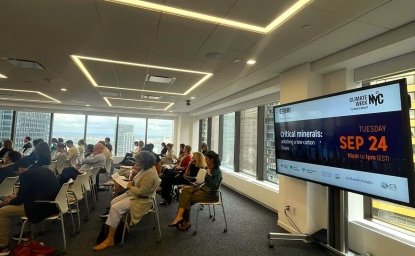
Critical Minerals: Unlocking a Low-carbon Future
